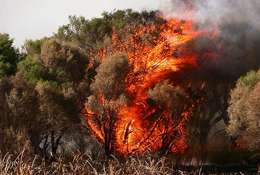Laser beams shed light on natures extreme events

(ĖĮÐÄĘÓÆĩ) -- 'Extremeâ events in nature, such as hurricanes, tsunamis and bushfires, may be more commonplace and predictable than you might think, according to scientists from The Australian National University who have been using lasers to study random events.
The international team led by Professor Nail Akhmediev from the ANU Research School of ĖĮÐÄĘÓÆĩics and Engineering, in collaboration with Philippe Grelu and Caroline Lecaplain from the University of Burgundy, France, and Jose Soto-Crespo from the Institute of Optics, Madrid, are using lasers to study how frequently extreme events happen. Their work, published in the latest ĖĮÐÄĘÓÆĩical Review Letters, highlights that in nature, âextremeâ doesnât have to mean ârareâ.
âA crucial factor in the appearance of extreme events, whether in nature, or a laser in the laboratory, is the existence of energy, or a background excitation in the system. This is a basic feature of so-called dissipative systems,â said Professor Akhmediev.
âSimply speaking, explosions and fires canât happen without fuel or another source of energy, hurricanes canât appear in still atmosphere, and rogue waves canât appear in completely still seas â instead, they accumulate energy from smaller waves.â
However, the abundance of energy around us all the time means there is a greater potential for extreme events, Professor Akhmediev explained.
âOur cities and our planet are densely filled with energy supplies, and a large source of energy is a potential field for extreme events. Without this background excitation, the events will stay within expected limits. But a continuous supply of energy can push the event off the expected limits, and into extremes,â he said.
Professor Akhmediev said that while we canât conduct dangerous experiments on a large scale in nature to illustrate the point, we can do it on a much smaller and safer scale through lasers in a laboratory.
âGenerally, itâs a bad idea to experiment with nature. However, we have the best example of a dissipative system in a laboratory, which is an optical laser. Modelling extreme events in laser systems is a great way to understand extreme events in nature.
âOur experimental results with a laser that operates in a strongly dissipative regime of chaotic multiple-pulse generation resemble the âchaoticâ processes in nature. What weâve found is that recorded intensity fluctuations resulting from the ceaseless relative motion inside the laser demonstrates that extreme events happen much more often than people expect.
âThis work suggests that transferring novel ideas born in a laboratory into the realm of natural hazards should be one of the objectives for science in the future,â he said.
Journal information: ĖĮÐÄĘÓÆĩical Review Letters
Provided by Australian National University



















